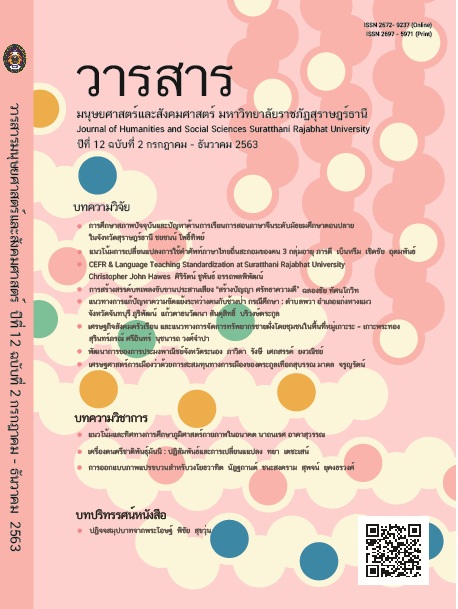CEFR and English Language Teaching Standardization at Suratthani Rajabhat University
Main Article Content
Abstract
This research article explores the ways in which the CommonEuropean Framework of Reference for Languages (CEFR) has been used at Suratthani Rajabhat University since it was first introduced in 2012. Using a mainly quantitative questionnaire, consisting of a section that sampled staff beliefs and opinions regarding CEFR and a section consisting of a general knowledge test designed to assess the staff's understanding of CEFR levels and benchmarks, the study found that the staff command a limited
understanding of CEFR and what it purports to do, and do in fact harbour some serious misconceptions about it. The article concludes by offering some suggestions to ameliorate such a shortcoming as a necessary step in improving the university's English curriculum design capabilities.
Article Details

This work is licensed under a Creative Commons Attribution-NonCommercial-NoDerivatives 4.0 International License.
All published manuscripts have been verified by peer-peer professors in the fields of humanities and social sciences. Reprinting of the article must be authorized by the editorial staff.
References
Alderson, J.C. (2007). The CEFR and the Need for More Research. The
Modern Language Journal. 91(4). 659-663.
Cambridge University Press (2015). EnglishProfile - The CEFR for English.
[Online] Retrieved from http://www.englishprofile.org/the-cefr
, August 8].
Council of Europe (2018). Historical Overview of the Development of the
CEFR. [Online]. Retrieved from https://www.coe.int/en/web/
common-european-framework-reference-languages/history [2019,
November 1].
Fennelly, M.G. (2016). The Influence of CEFR on English Language Teaching
in Japan. [Online]. Retrieved from https://www.shikoku-u.ac.jp/
education/docs/A46p109-122.pdf. [2018, October 6]
Foley, J.A. (2019a). Issues on Assessment Using CEFR in the Region. LEARN
Journal: Language Education and Acquisition Research Network
Journal. 12(2). 28-48.
Foley, J.A. (2019b). Adapting CEFR for Use in ASEAN, Japan and China. The
New English Teacher. 13(2). 101-117.
Franz.J, & Teo, A. (2018). 'A2 is normal‘- Thai secondary school English
teachers‘ Encounters with CEFR. RELC Journal, 49(3), 322-338.
Liu, D. (2015). A Critical Review of Krashen’s Input Hypothesis: Three Major
Arguments. Journal of Education and Human Development. 4(4).
-146
Moser, Jason. (2018). From a knowledge-based language curriculum to a
competency-based one: The CEFR in action in Asia. Asian EFL
Journal. 2015. 113-135.
Noom-ura, S. (2013). English-Teaching Problems in Thailand and Thai
Teachers Professional Development Needs. English Language
Teaching. 8(11). 139-147.
North, B. (2008). The relevance of the CEFR to teacher training. Babylonian
(2008). 55-57.
Poszytek, P. (2012). Policy perspectives from Poland. In M. Byram & L.
Parmenter (Eds.), The common European framework of reference:
The globalization of language education policy. Bristol: Multilingual
Matters. 97-103
Sornkam, B., Person, K.R., & Yordchim, S. (2018). Reviewing the Common
European Framework of Reference for Languages in Thailand
Higher Education. Graduate School Conference 1(2). 1-7.
Urkun, Z. (n.d.). Re-evaluating the CEFR: An Attempt. Sabanci Universiti
School of Languages Webpage. Retrieved from https://
sl.sabanciuniv.edu/sl-blogs/re-evaluating- cefr-attempt [2019,
January 15].
Uri, N.F. & Aziz, M.S. (2018). Implementation of CEFR in Malaysia: Teacher's
Awareness and the Challenges. The Southeast Asian Journal of
English Language Studies. 24(3). 168–183.
Wilson, J. (2012). English Language Major Programmes at Suratthani Rajabhat
University, Thailand -- An External Evaluation and a Proposal for
Reform: unpublished.


